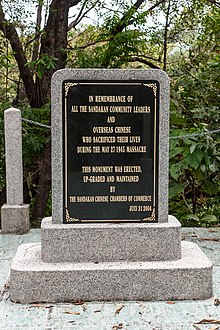Sandakan Massacre Memorial
The Sandakan Massacre Memorial is a memorial that commemorates the Chinese victims from Sandakans on May 27, 1945, during which the Japanese occupiers of Sabah executed more than 30 Chinese during World War II - members of the local leadership who, according to the occupiers, were involved with the Connected or supported the underground movement.
The memorial was built on the place where the massacre took place and where the victims were buried. The memorial is located near the Chinese cemetery on a hill ( Rea Hill ) above the old town center of Sandakan .
description
The memorial is located near the entrance to the Sandakan Chinese Cemetery. To the right of the gate, concrete steps lead about six meters high to a small elevation, which is crowned by a tiled square six meters on each side. Stone posts connected by link chains delimit the memorial, which consists of an approximately three meter high stele and two flanking memorial stones.
stele
The stele bears the inscription in red Chinese characters:
“Memorial to the Chinese who died on May 27, 1945”
Memorial stone on the left
The black marble memorial stone to the left of the stele reminds in gold letters of the events that led to the massacre and lists the names of the Chinese who were executed.
Memorial stone on the right
The black marble memorial stone to the right of the stele bears the inscription in gold letters dated July 31, 2004:
“In Remembrance Of All The Sandakan Community Leaders And Overseas Chinese Who Sacrified Their Lives During The May 27 1945 Massacre
This Monument Was Erected, Upgraded And Maintained By The Sandakan Chinese Chambers Of Commerce”
This memorial was erected, extended and maintained by the Sandakan Chinese Chamber of Commerce
Historical background
When it became apparent in the spring of 1945 that Japan might lose the war, the Japanese occupiers in Sandakan began to arrest the city's ruling class. On the orders of the officer on duty Taisa ( Colonel ) Machiguchi Taku from the Kempeitai responsible for Borneo, Kwan Yun Hin - former chairman of the Chinese Chamber of Commerce Sandakan and representative of the Chinese population of British North Borneo in the State Legislative Council - and seven were appointed on May 6, 1945 other people arrested.
After an Allied air raid on May 27, followed by a three-hour bombardment by five or six PT speedboats , the speedboats landed in the port of Sandakan. Some city officials met with the US soldiers. It was not the long-awaited invasion, however, as the boats left Sandakan that same night. As a result of this contact with the Allies, the Japanese immediately arrested 27 people; most of them belonged to the city's Chinese ranks.
Those arrested were taken to the Kempeitai headquarters. They were found guilty in absentia by the Sandakan District Court based on alleged confessions.
The massacre
After Captain Nakata Shiruchi read the verdict, the group was escorted to the hill behind the headquarters and shot in groups of four with a machine gun. Other sources indicate that the convicts were beheaded. Ten holes in the ground had been dug there before the execution, in which the bodies of the men were buried.
Besides the Chinese victims, members of other nationalities were also among the murdered:
- MS Patel, the owner of Sandakan's Pharmacy,
- Mrs. Linck, the wife of the German pharmacist employed there,
- KA George, Member of the City Council,
- Richard Watson, Accountant,
- P. Dominic, retired customs officer,
- Alfred Funk, co-owner of Funk & Sons ,
- Jappar, dealer
as well as an Indian doctor. Not all those executed are known by name. It is generally believed that the number of victims is far greater than the list of names on the memorial stone.
History of the memorial
Shortly after the war, the people of Sandakan erected a memorial stone dedicated to the victims of the occupation within Sandakan. This memorial stone, which stands in the square in front of the District Office today, was inaugurated on September 17, 1946 by the British Governor General of Malaya and British Borneo, Sir Malcom MacDonald. The Chinese community, represented by the Chinese Chamber of Commerce Sandakan, followed this example a short time later and in turn inaugurated a monument; this was specifically dedicated to the victims of the massacre of the Chinese population. This memorial initially only consisted of the stele with the inscription that still exists today.
In 2004 the monument was renovated and the two flanking memorial stones were added. The preservation and maintenance is still in the hands of the Chinese Chamber of Commerce Sandakan.
Since the opening of the memorial, a memorial service organized by the descendants of the victims has been held every year on May 27th.
Of the Japanese officers who were in Sabah during their military service, 420 were charged as war criminals. Captain Nakata Shiruchi of the Kempeitai Sandakan was among those sentenced to death.
literature
- Danny Wong Tze Ken: Historical Sabah: The War , Opus Publications Kota Kinabalu, 2010, ISBN 978-983-3987-37-5
Web links
Individual evidence
- ↑ Danny Wong Tze Ken; Pp. 134-135
- ↑ a b Danny Wong Tze Ken; P. 135
- ↑ Alex Khoo, son of the murdered Chong Wai Cho, in an article in SANDAKAN REMEMBRANCE SERVICE · August 6, 2006 (PDF; 1.4 MB), pages 22–24; Accessed September 5, 2012
- ^ Danny Wong Tze Ken, p. 139
- ↑ see inscription on the memorial stone to the right of the stele
Remarks
- ↑ The reason for the imprisonment of Kwan was his leading position in the China Relief Fund , an organization that raised funds for the war of China against Japan from 1937 , and his support for the North Borneo Chartered Company .
Coordinates: 5 ° 50 '36 " N , 118 ° 7' 13.5" E




